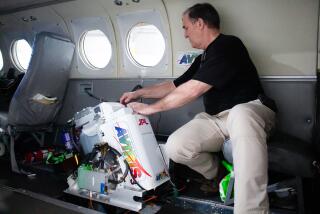Scientists to Monitor Mountain Gas Emission
- Share via
Scientists are examining a new emission of carbon dioxide, indicating possible underground volcanic activity, in the Eastern Sierra about 10 miles from gas emissions noticed in recent years on Mammoth Mountain.
The U.S. Geological Survey said this week that it will install sensors about seven miles northeast of the town of Mammoth Lakes in an effort to measure and monitor the freshly reported emissions. The site is at the southern end of the Los Angeles Department of Water and Power’s Mono Craters Tunnel.
Detection of carbon dioxide in the sparsely populated area may indicate the spreading of underground intrusions of lava between Mammoth Mountain and the Mono Lake area, although this remains to be confirmed by the sensors, said Chris D. Farrar, the scientist in charge of monitoring volcanism in the region for the Geological Survey.
Farrar and Michael Sorey, a survey gas emissions expert, said they want to determine if the carbon dioxide concentrations--reported in the 4% to 5% range, with anything over 3% a threat to humans--vary over time and whether the gas is under pressure inside the DWP tunnel.
“Specifically, we want to see whether the gas has the same kind of carbon isotope signature that we see on Mammoth Mountain,” Sorey said. The sensors, to be installed in February, will be identical to those put in last year at Horseshoe Lake on the south side of Mammoth Mountain.
Similar findings would indicate a second magmatic, or lava, intrusion under the surface in an area close to the Mono Craters, the site of a major eruption several hundred years ago.
Kerry Sieh, a Caltech professor of geology who has conducted research in the area, said there is evidence of a Mt. St. Helens-size eruption that began near the craters on the south shore of Mono Lake about 1350.
Sieh said there also was another eruption with heavy ashfalls in about 610 in the immediate vicinity of the present DWP tunnel, which was drilled in the 1930s to carry water from the Mono Lake Basin to the Owens River along the route of the DWP’s aqueduct to Los Angeles.
Altogether, there is evidence of past volcanic activity over a 20-mile line from Mono Lake to Mammoth Mountain, Sieh said.
Although scientists have been paying close attention to the carbon dioxide emissions, and some ensuing tree kills as well as seismicity in the area, they have reached no conclusions about the likelihood of a new eruption soon.
Glenn Singley, the northern district engineer for the DWP in Bishop, said this week that there were recordings of carbon dioxide and carbon monoxide gas when the tunnel was drilled more than half a century ago.
But recently, he said, fresh interest was aroused when a DWP worker became dizzy, apparently after breathing carbon dioxide emissions while measuring the flow of water at the mouth of the tunnel.
“We talked to the Geological Survey about the gas because we were interested in what was going on, and they asked us whether they could monitor it,” Singley said. “We aren’t alarmed, but we welcome the sensors.”
DWP engineers can travel the length of the mostly empty tunnel, he said, but they have been careful to use blowers to expel dead air before undertaking such an expedition.
(BEGIN TEXT OF INFOBOX / INFOGRAPHIC)
Sniffing for Volcanoes
A new area of carbon dioxide gas emissions that may indicate underground volcanic activity has been detected in the Eastern Sierra. A new test site has been set up about 10 miles northeast of earlier emissions near Mammoth Mountain.
More to Read
Sign up for Essential California
The most important California stories and recommendations in your inbox every morning.
You may occasionally receive promotional content from the Los Angeles Times.










